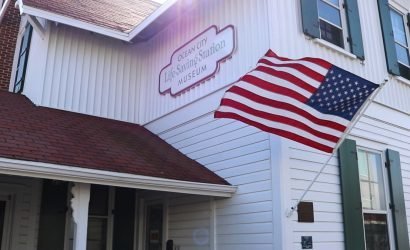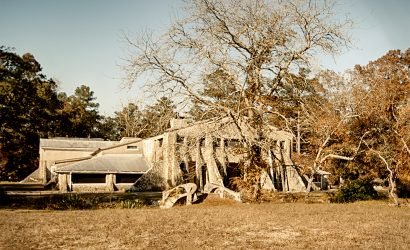Nearly one hundred years ago, a gentleman took his surrey, his horse, and his lady out into the woods on the outskirts of Snow Hill , MD to an area known locally as “the furnace.” This simple act, in the days before drive-in-theaters, movies in general, and vehicles, was called “sparking.” The meaning is not the assumed modern-day blending of two words—“surrey” and “parking”—it means something much more innocent. In those days, if you were a gentleman who happened to take a girl out into a darkened area, you may have to pull her close, and perhaps a “spark” would ignite–leading to that longed for, and almost forbidden–kiss.
Though locals were fond of the “furnace” area for after-dark activities, it would take a massive fire in the 1930’s that engulfed a majority of the forested area, to reveal what had lain buried beneath the brush and decay since 1850–to the public at large.
A small town, built from the ground up—really an early form of what would currently be called a development, sprung up in the middle of an unpopulated area after the land was purchased in 1828. Much like contemporary developments, this 5,000-acre parcel of land was cleared of all timber–only homes, the church and vital businesses dotted the landscape of the once heavily forested area. The reason for the town, initially called Furnace Hill, was discovered in the nearby Nassawango Creek, in the form of iron ore.
The iron ore itself, together with trees that could be turned into charcoal for fuel, and oyster shells, whose calcium component acted as flux—a purifying agent, all combined when heated at very high temperatures to make iron, specifically what was known as “pig iron.” The town at Furnace Hill was situated around an enormous brick furnace stack—still standing today, it is a historical landmark and remains a critical part of the early iron industry.
The furnace was built in an area already home to a saw and gristmill, but to enable the iron to be transported from the furnace, workers dug a one mile long, twenty feet wide, and eight feet long canal—by hand—to the nearby Nassawango Creek, where the iron could be further transported via waterways to the major cities on the east coast.
According to former Furnace Town Executive Director, and current Board of Directors President, Kathy Fisher, the area the furnace is built upon is really a swamp. When workers attempted to build the furnace, the massive rock bases that usually acted as the base support, kept sinking. The furnace is actually built on an engineering feat—a 24 foot square cypress base, meaning that the furnace is technically floating. Though Fisher doubts that over one hundred and eighty years after it’s completion—a structure that heavy would still be “floating.”
Furnace Hill—which came to be known as Furnace Town was sold several times in its short history. The last owner of the furnace, Thomas Spence, a Worcester County native, lawyer and Circuit Court Judge did manage to run a successful business there for a number of years, despite the fact that the iron produced was of lesser quality than iron produced in the north. Eventually, it would be a case of irony that proved to be the furnace’s ultimate demise. Furnace Town relied on the waterways to ship their iron. Yet the iron produced supplied the railroad industry. This new form of transportation was faster than relying on the waterways. Eventually, Furnace Town, with its somewhat inferior product, and slow mode of transportation, went out of business—with owner Thomas Spence claiming bankruptcy in 1850. No industry meant no feasible way to earn an income—all residents had to vacate, taking with them all personal belongings, and leaving Furnace Town a veritable ghost town.
One infamous resident, Sampson Harmon decided to stay, until he was forced out and to the Alms House in Snow Hill. His reported last wish was to be buried at Furnace Town, a request that was denied. Rumors circulate that Sampson may haunt Furnace Town to this day—but this version is likely just an example of local folklore. Kathy Fisher who has worked on the property for 22 years says,
“He lived here for so long, you get a sense his spirit—not a ghost, but his spirit remains as part of the town.”
Sampson’s only companion was his black cat, Tom. Visitors to the current Furnace Town will be likely be greeted by a number of cats that now inhabit the land. Descendents of the original Tom perhaps, or cast-offs from neighboring areas—the answer is anybody’s guess.
After the furnace’s abandonment in 1850, the forest and decay took over, enveloping the structures. New owners purchased the property for timber, and locals used he grounds at night for parties deep in the woods. After the fire in the 1930’s the old furnace resurfaced and concerned and notable citizens took an interest. By the 1960’s the property had been rescued for preservation. Kathy Fisher recalls reports that a number of dump trucks were called in to haul out load after load of beer bottles—illustrating the property’s other bit of history—the infamous parties in the woods that harken back to the days of “sparking.”
Currently, Furnace Town is a living and working museum. The buildings themselves aren’t the original structures—those that managed to survive decay were completely destroyed in the massive fire in the 1930’s. The town is now populated with donated local buildings authentic to the 1820’s-1850’s time period–two churches, (one acts as the museum), a blacksmith’s shop, a weaver’s cottage, among others—are re-purposed as examples of living history. According to Kathy Fisher,
“We were really recycling and re-purposing before it was ever the ‘in’ thing to do. Nearly every building and artifact on the property was obtained from within an 80-mile radius.”
Fisher credits Ed Hammond and Jack Graham—the latter’s name adorns a plaque at the entrance, designating him as the town’s mayor—with really resurrecting the town. Graham in particular was responsible for the current footprint, which enables modern-day visitors to wonder the pathways, enter the buildings–where real working artisans, a blacksmith, and a weaver who works off of a 280-year old loom, among others—showcase what life was like nearly two centuries ago.
Furnace Town hosts a number of events—a Victorian church service at Christmas time, ghost hunts in partnership with a paranormal group on a regular basis, school trips, and even archeological digs.
The digs have uncovered a number of artifacts over the years—mostly pieces of what was once whole—pottery, nails, glass, all neatly filed away in boxes, just waiting for the right person, perhaps a doctoral student with a lot of patience for tedious but important work, to catalogue them all.
The future of Furnace Town could be a move toward bringing in technology to further explain the past. Interactive signage, enabled with video segments for smart phones may one day soon dot the landscape. But as for the town itself, the buildings and the furnace will remain the same—preserving the past for future generations.
Visit Furnace Town this weekend for the 22nd annual Celtic Festival–Saturday and Sunday October 1st and 2nd—artisans, whiskey tastings, music and more. New this year is a Celtic Rock concert Saturday night. Perhaps the festive music and numerous libations will rouse the spirits who first brought the party atmosphere to the woods many years ago.









